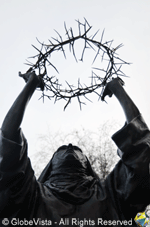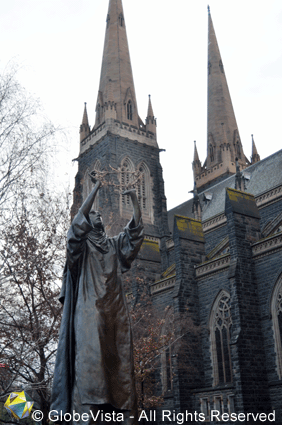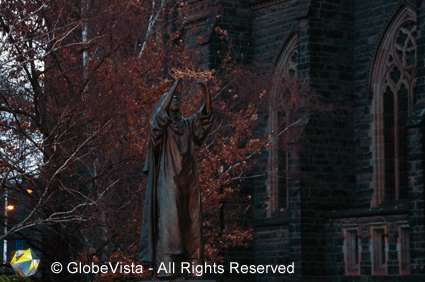St Catherine of Siena statue

Public Art: St Catherine of Siena statue
Sculptor: © Louis Laumen
 Description: A bronze statue of St Catherine (25th March 1347 – 29th April, 1380), the patron saint of Italy, holding a crown of thorns up towards the heavens. The statue depicts a vision she had of Christ offering her either a crown of gold or a crown of thorns. She chose the crown of thorns. The crown is impaling her hand, a sign of stigmata.
Description: A bronze statue of St Catherine (25th March 1347 – 29th April, 1380), the patron saint of Italy, holding a crown of thorns up towards the heavens. The statue depicts a vision she had of Christ offering her either a crown of gold or a crown of thorns. She chose the crown of thorns. The crown is impaling her hand, a sign of stigmata.
Date Unveiled: The St Catherine statue was unveiled in December 2000.
Location: St Patrick’s Cathedral, corner of Gisborne Street & Cathedral Place, East Melbourne, Victoria, Australia.
So who was Saint Catherine of Siena?: Caterina Benincasa was born in the fortified city of Siena, in Italy, during the time of the black death. Her twin sister Giovanna died soon after birth. At the age of 5 Caterina had her first vision of Christ in which Jesus smiled at her. By the age of 7 she had vowed chastity.
Unfortunately, at the age of 16 her older sister Bonaventura died and her parents arranged for her to marry her sister’s widower. She was to have none of that and protested by going on a hunger strike. She would later confess that during this troubled time she built a cell inside her mind, from which she could never flee. As Caterina grew weaker and weaker her father eventually relented.
On seeing a vision of St Dominic she persuaded her mother to allow her to join the Third Order of St. Dominic despite her disapproval. Having being accepted she donned on the black and white habit and returned home to almost total silence and solitude.
Much to her family’s annoyance and expense, Caterina began giving away food and clothing without so much as a thought for her large family’s welfare.
 Around 1366 Catherine had what she described as a “Mystical Marriage” with Jesus. She also claimed to have received communion from Christ himself and had suffered stigmata (unexplained bleeding). In her letters she told of how Christ had told her to leave the confines of her family home and join the rest of the world. She did this with enthusiasm, helping both the sick and the poor. She soon had a small group of followers who brought Catherine’s work to the attention of the Dominican Order. They in turn called her to Florence in 1374 where they promptly interrogate her, fearing heresy.
Around 1366 Catherine had what she described as a “Mystical Marriage” with Jesus. She also claimed to have received communion from Christ himself and had suffered stigmata (unexplained bleeding). In her letters she told of how Christ had told her to leave the confines of her family home and join the rest of the world. She did this with enthusiasm, helping both the sick and the poor. She soon had a small group of followers who brought Catherine’s work to the attention of the Dominican Order. They in turn called her to Florence in 1374 where they promptly interrogate her, fearing heresy.
She managed to pass the interrogation and continued to travel throughout northern and central Italy advocating reform of the clergy and encouraging people to repent through the “the total love for God.”
A prolific letter writer, Catherine spent much of her time dictating letters to her various scribes which were then later sent to her followers and people of authority. Many of these letters focused on the desire to return the Papacy back to Rome. As from 1309 to 1376 all of the consecutive popes resided in Avignon (modern day France) thanks to Clement V, a Frenchman, who on being elected pope in 1309 refused to live in Rome. A very big sore point in Italian history.
In 1376 Catherine decided to travel to Avignon herself in an attempt to convince Pope Gregory XI to return to Rome. Her power of persuasion must have worked because the following year he did return.
Two years later Pope Gregory XI was dead and the Catholic Church was virtually split in two when two men claimed to be the true pope. This period was known as the Great Schism. Pope Urban VI was elected in 1378 but he proved to be violent and overbearing. The majority of cardinals left Rome and went to Anagni where they elected a rival pope, Pope Clement VII, and then promptly re-established a papal court in Avignon. Confusion ensued. Catherine was called upon by Pope Urban VI to convince nobles and cardinals of his legitimacy. This would cause her great turmoil up until her death from a stroke in 1380. Catherine was only 33.
Catherine was originally buried in the cemetery of Santa Maria sopra Minerva near the Pantheon in Rome, but following numerous reported miracles, her remains were placed in the Basilica of Santa Maria sopra Minerva.
When news of Catherine’s death reached Siena, the people wished for her body to be returned to her hometown. Knowing full well there was no way they could steal her whole body, they decided to remove just her head and thumb. They placed it in a bag and fled from Rome but were stopped by some Roman guards. In fear of being caught as body snatchers they prayed to St Catherine. Low and behold when the soldiers took a peak into the bag all they saw were rose petals. This is why you often see images of Saint Catherine holding a rose.
Pope Pius II canonized St Catherine in 1461 and on May 5, 1940 Pope Pius XII named her a joint Patron Saint of Italy along with Saint Francis of Assisi.
St Catherine Trivia: There is a statue of St Catherine in Rome near the Castel Sant’Angelo and the Vatican.
Her mummified head and thumb are on display in the Basilica San Domenico in Siena. One of her feet is said to be in a shrine in Venice while the rest of her body resides in Rome.